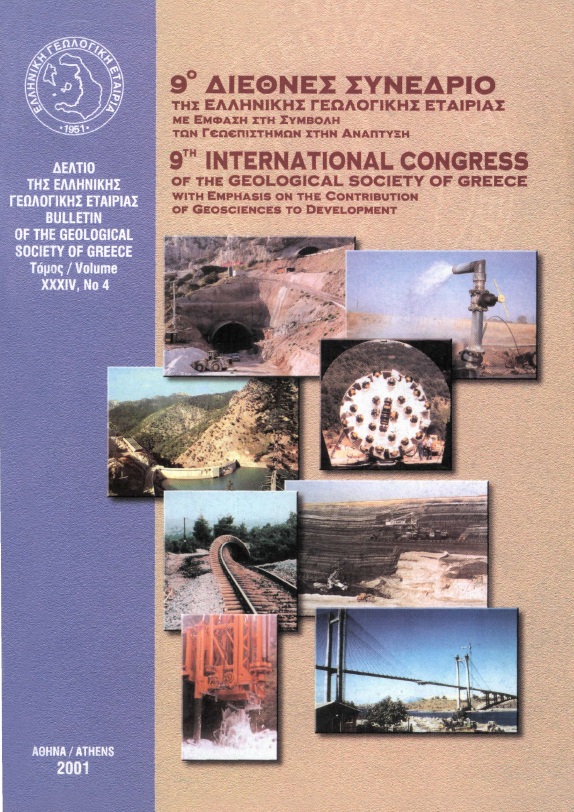Spatial distribution of the seismic hazard parameters in the seismogenic sources of Japan
Περίληψη
Με την εφαρμογή δύο διαφορετικών προσεγγίσεων έγινε η εκτίμηση των παραμέτρων σεισμικότητας στις σεισμογενείς πηγές της Ιαπωνίας. Οι μέθοδοι αυτές είναι α)η μέγιστη πιθανοφάνεια και β) η στατιστική Bayes. Αμφότερες οι μέθοδοι μπορούν να εκτιμήσουν το μέγιστο δυνατό μέγεθος του σεισμού Μ , την ποσότητα που β είναι η κλίση της καμπύλης της σχέσης της συσωρευτικής κατανομής των σεισμών και τον μέσο ρυθμό y[ των σεισμών. Στην παρούσα εργασία επικεντρώνουμε το ενδιαφέρον μας στην εκτίμηση των δύο πρώτων παραμέτρων ερευνώντας για την ύπαρξη πιθανού μοντέλου της γεωγραφικής τους κατανομής στις σεισμογενείς περιοχές τις Ιαπωνίας. Δύο είναι οι βασικές υποθέσεις για την αποδοχή των μεθόδων που εφαρμόζονται: 1) ότι οι σεισμοί ακολουθούν κατανομή Poisson και 2) ότι ισχύει ο νόμος Gutenber-Richter. Οι μέθοδοι επιτρέπουν τον υπολογισμό του σφάλματος για τα μεγέθη των σεισμών. Γενικά δείχθηκε ότι οι τιμές Μ είναι διαφορετικές και μεγαλύτερες από τις παρατηρημένες τιμές Mmax . Οι τιμές της παραμέτρου που υπολογίστηκαν βρέθηκαν ότι είναι πολύ χαμηλές για τις σεισμογενείς ζώνες 2 και 7. Αυτό σε συνδυασμό με τις παρατηρήσεις άλλων ερευνητών μας οδηγούν στο συμπέρασμα ότι στις περιοχές αυτές είναι πιθανή η γένεση μεγάλου σεισμού
Λεπτομέρειες άρθρου
- Πώς να δημιουργήσετε Αναφορές
-
TSAPANOS, T. M., KORAVOS, G. C., PATSIA, C. I., & KOULARAS, D. T. (2001). Spatial distribution of the seismic hazard parameters in the seismogenic sources of Japan. Δελτίο της Ελληνικής Γεωλογικής Εταιρείας, 34(4), 1627–1633. https://doi.org/10.12681/bgsg.17272
- Ενότητα
- Σεισμολογία

Αυτή η εργασία είναι αδειοδοτημένη υπό το CC Αναφορά Δημιουργού – Μη Εμπορική Χρήση 4.0.
Οι συγγραφείς θα πρέπει να είναι σύμφωνοι με τα παρακάτω: Οι συγγραφείς των άρθρων που δημοσιεύονται στο περιοδικό διατηρούν τα δικαιώματα πνευματικής ιδιοκτησίας επί των άρθρων τους, δίνοντας στο περιοδικό το δικαίωμα της πρώτης δημοσίευσης. Άρθρα που δημοσιεύονται στο περιοδικό διατίθενται με άδεια Creative Commons 4.0 Non Commercial και σύμφωνα με την οποία μπορούν να χρησιμοποιούνται ελεύθερα, με αναφορά στο/στη συγγραφέα και στην πρώτη δημοσίευση για μη κερδοσκοπικούς σκοπούς. Οι συγγραφείς μπορούν να: Μοιραστούν — αντιγράψουν και αναδιανέμουν το υλικό με κάθε μέσο και τρόπο, Προσαρμόσουν — αναμείξουν, τροποποιήσουν και δημιουργήσουν πάνω στο υλικό.




